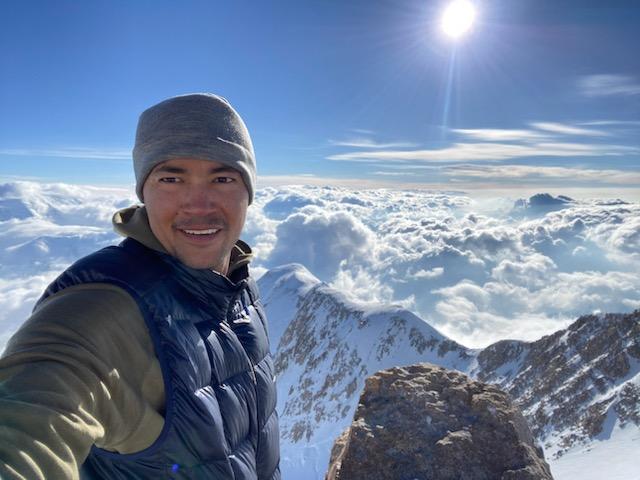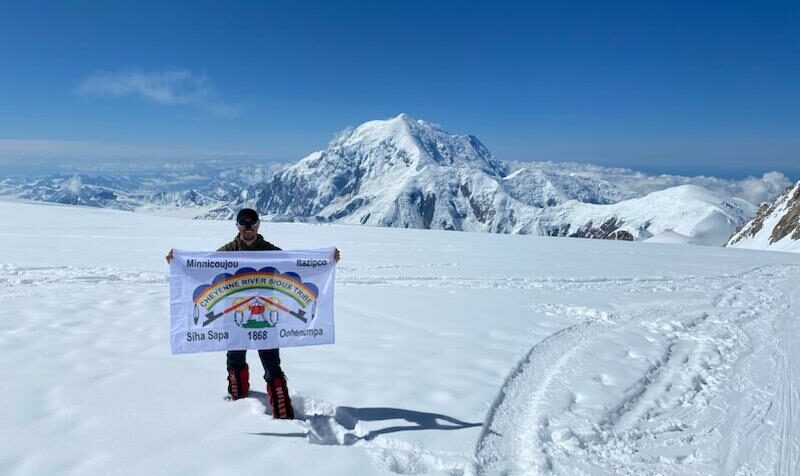

Most people like to overcome a challenge from time to time — it feels good to achieve a new best, to accomplish a goal. It’s a good thing to push ourselves, to climb these metaphorical mountains. For General Surgeon Jacob Weasel, M.D., however, the mountains aren’t metaphors.
Dr. Weasel’s interest first piqued as an undergraduate student, when a professor-turned-friend shared his experience on a team trying to summit Mount Rainier in Washington. It stuck with him, though he wouldn’t have a chance to tackle the mountain himself until after he finished his education. “The summer after I finished my training, I went out there and did a four-day mountaineering course. They teach you crevasse techniques, self-arrest skills with an ice axe, how to travel in a roped team, glacial travel techniques and things like that,” he said. “Then you attempt the summit. We had great weather, and of the nine climbers that started, three of us actually reached the summit.”
Dr. Weasel was hooked, and mountaineering took him to Ecuador to climb Cotopaxi and Chimborazo, to Africa to summit Kilimanjaro, and eventually to Alaska to climb Mount Denali, the highest peak in North America, with a summit elevation of 20,310 feet above sea level.
“Denali is a totally different experience than anything else that I’ve ever done,” Dr. Weasel said. “At no point on the summit day did I ever want to turn back. I was one of maybe three climbers, out of 12, that felt that way.” The group spent 17 days on the mountain, with night temperatures reaching as low as -50 with windchill, waiting for the window to summit. Finally, when they were nearly out of food, they had a chance. After clearing the most dangerous section of the summit stretch — dubbed the autobahn — they were hit with gusts of wind reaching 50 miles per hour. The group would have been exposed to those winds, and temperatures around 20 degrees below freezing, for 12 to 15 hours to summit and return to camp. The guides, realizing that it was likely that the climbers would lose fingers and toes in those conditions, initiated the turnaround. “It was the only time that I’ve ever had to turn around on a mountain, and that was pretty tough.”

Not making the summit hasn’t slowed Dr. Weasel down at all — if anything, it’s fired him up. His next challenge? Earth’s highest mountain, Mount Everest.
Oddly enough, the ultimate peak on the planet didn’t hold a specific draw to Dr. Weasel until recently. As an enrolled member of the Cheyenne River Sioux Tribe, he realized that summiting Everest would provide an opportunity to inspire young Native Americans. “It’s important to me to inspire native youth, and I think this is an opportunity for them to see that they are equally capable as anybody else to do whatever it is that they want in life.”
Dr. Weasel also aims to provide more than inspiration, which is the motivating factor for the creation of the Wopila Project, a non-profit he developed to cultivate gratitude and generosity, and to make a positive impact in communities in need. “Wopila is a Lakota expression of gratitude for all that life has to offer,” he said. “I feel extremely blessed and I wanted to find a way to give back.”
Dr. Weasel is using his Everest bid as a way to bring attention to the Wopila Project. The non-profit is currently working to fund and construct a playground at the Lakota Homes housing community in Rapid City, and sustainable women’s health clinics in Nepal.
“Really, Everest is only the beginning,” Dr. Weasel said. “My goal is to be the first Native American to summit the Seven Summits, which is the highest mountain on each continent. I hope that as I work to accomplish that goal, the Wopila Project can do some real good along the way.”